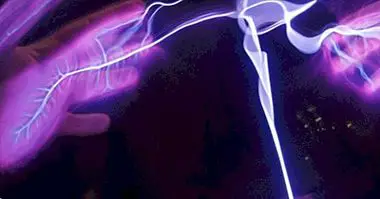Depersonalization disorder: symptoms, causes and treatment
Imagine that we had never seen each other in a mirror and one day happened to see our reflected image: it is probable that at first we felt a certain surprise and we even asked ourselves if that person is us. Imagine also that we had a camera behind us and we were seeing the image as if it were a movie: probably our acts reflected on a screen would be strange to us, as if we were more than spectators of them.
Now imagine that these sensations of strangeness could not be explained by the novelty or the context: this is what happens to people who suffer from a specific type of disorder, depersonalization disorder .
- Related article: "The 18 types of mental illnesses"
Depersonalization disorder
It is called depersonalization disorder to a type of dissociative disorder, which are characterized by supposing a certain rupture between mental faculties or a discontinuance or disconnection between them. In the case of depersonalization disorder, it is the recognition or familiarity with oneself that has been disconnected.
Depersonalization disorder is characterized by the existence of an experience of great strangeness towards oneself . The feeling of being unreal appears, of not being an actor but an observer of our own actions, absence of a self and / or sensation of mental and physical numbness. Although a sensation of this type may not be symptomatic sporadically, if the existence of this disorder is considered when these sensations occur in a habitual and / or persistent manner.
The presence of a sense of discorporization or of not being in one's own body is common, an experience of lack of belonging to one's body. All this generates a clinically significant malaise and suffering and / or a limitation in the day to day of the person.
The experience of this disorder can be really distressing, given the feeling of not being real despite knowing the subject at a conscious level that it is . It is not strange that a great fear of the idea of losing one's sanity may appear, or even of identifying oneself as a living dead. Problems of concentration and performance often appear in multiple tasks, including work. Depression and anxiety are often frequent if the problem is not solved, and in some cases suicidal thoughts may appear.
It is important to bear in mind that we are not dealing with a case of delirium or psychotic disorder, being also the judgment of reality preserved (although there may also be strangeness towards the environment is still known that this is real) and not being caused by other mental disorders , medical illnesses or substance use. Despite this it is worth mentioning that depersonalization can appear as a symptom in these contexts, although in this case we would be talking about depersonalization as a symptom and not as a disorder per se.
Another linked alteration: derealization
Depersonalization disorder may occur only as a strangeness to oneself, but it is relatively common that the sensations of strangeness towards one's own person are also given to the perception of reality .
We are talking about derealization, where there are difficulties in the perception of the reality of things, often identifying the sensation as being dreaming and perceiving the world as something unreal and false. Time and space are perceived as altered and the world goes on to give a sense of artificiality and distortion.
- Related article: "Depersonalization and derealization: when everything seems like a dream"
Causes
The possible causes of the appearance of the disorder of depersonalization can be multiple, there is not a single possible cause for this and being the concrete causes of its appearance unknown in the majority of the cases.
However, as a dissociative disorder that is usually associated with the experience of highly stressful situations. Continued psychosocial stress, the presence of sexual abuse in childhood or in the present, the presence of high levels of panic, situations of mourning before the death of loved ones or other traumatic events can be probable cause or relatively frequent triggers.
At a biological level, it has been observed in some experiments that patients with this disorder they have less activation in the sympathetic autonomous system and a reduction of the electrodermal activity. A lower activation of the insula and an activation in the ventrolateral prefrontal cortex have also been observed before unpleasant stimuli.This pattern seems to reflect a defensive behavior when presenting aversive stimuli, reducing the emotional response to them and producing part of the symptomatology.
Also, although we would no longer be talking about the disorder itself but depersonalization as a symptom, these episodes may also appear in cases of poisoning for substance use, poisoning, traumatic brain injuries or confusional states.
- Maybe you're interested: "Sympathetic nervous system: functions and travel"
Treatment of depersonalization
Depersonalization can be treated through psychotherapy, although in many cases we are dealing with a chronic disorder or can disappear to return to situations of stress and anxiety .
In general, the treatment will depend on the situations that triggered the disorder, being necessary to work together with the subject the moment of appearance of the disorder, the sensations that generate it and what it is associated with. It will also be necessary to perform psychoeducation and work on possible complications, such as the onset of depression. Training in problem solving and stress management can be useful, as well as trying to strengthen the connection with oneself (for example by rooting techniques). One can work from multiple perspectives, such as the cognitive restructuring characteristic of the cognitive-behavioral current or psychodynamics.
Sometimes the application of different psychotropic drugs may also be useful, although there is little evidence in this regard. However, some studies seem to indicate that some substances have some efficacy, for example the anticonvulsant known as lamotrigine or opioid antagonists such as naltrexone.
Bibliographic references:
- American Psychiatric Association. (2013). Diagnostic and Statistical Manual of Mental Disorders. Fifth edition. DSM-V. Masson, Barcelona.
- Burón, E .; Jódar, I. and Corominas, A. (2004). Depersonalization: from the disorder to the symptom. Spanish Acts of Psychiatry, 32 (2): 107-117.
- Sierra-Siegert, M. (2018). Depersonalization: clinical and neurobiological aspects. Colombian Journal of Psychiatry, 37 (1).



















